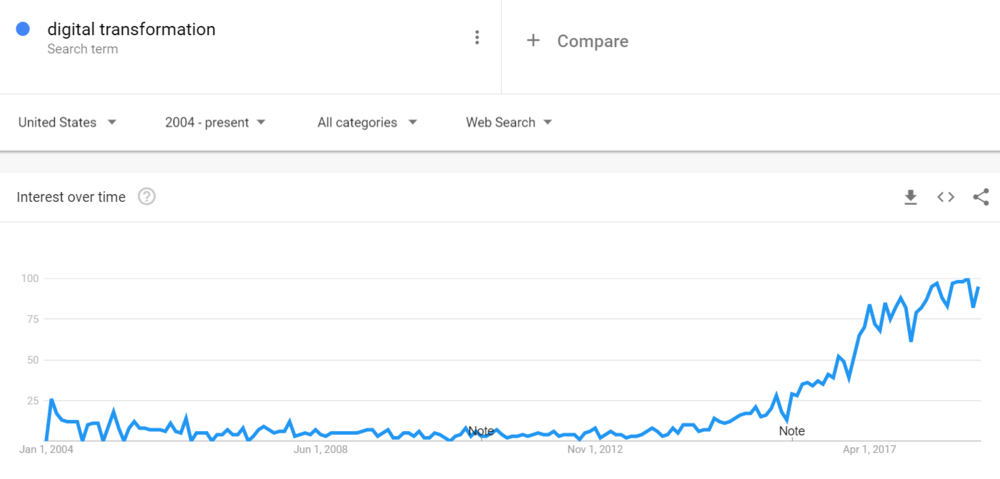Digital Transformation (also known as “DX”) is the phenomenon that virtually all companies are incorporating digital technology at some level. The digitization might be specific internal processes, tools, or operational components, or can refer to a complete revamp of a company’s products and services.
The term is not new. In fact, it has been around since the 1990s, when technology started to become commonplace in businesses, and email and the Internet emerged as ubiquitous productivity tools.
The term began gaining popularity in the corporate world around 2013, and since then, digital transformation has become synonymous with the digitization of customer-facing products.

Google Search Data for the phrase “digital transformation” from Google Trends
Digital products in the hands of customers, such as banking, airline or music apps, represent the last piece of the digitization puzzle since many of the back-end systems and processes became computerized over the last several decades.
Now that these product evolutions are everywhere, from automobiles to sub-zero refrigerators, the idea of digital transformation has become a top strategic priority for many enterprises.
Easier said than done.
While just like for startups, large enterprises benefit from the tumbling costs of developing digital products, they face deep-rooted problems that come from being large and successful. They are typically not structured to be close to their customers, their processes are slow and are burdened with hierarchical decision-making and cross-silo bureaucracy.
Not sure where your organization is on the journey to transformation?
Click here to take our free assessment and find out.
The fundamental issue: the way people think and work has not changed to fit the new digital reality — people and processes are the bottleneck.
Digital transformation is just as much about changing the company culture as it is about the technology.
The Shift Towards Consumer Power
Since we live in the Age of Information, consumers have more insight about the products they purchase, the companies they wish to buy from, and are more empowered to make choices that fit their needs.
The progress of technology starts at the core and then works its way to the edge. This shift is due to complexity and cost. High complexity and high cost means the only organizations that can afford the technology are government, academia and very large companies. Computer technology started as huge mainframes in the world’s biggest organizations. As complexity and costs decrease, the technology migrates to the edge.
Powerful computers are now in just about everyone’s pockets.
Along this progression, as more people have access to the technology, they become empowered to make their needs known and to make choices on products that fit their needs. The trend is that companies make more models that fit the increasing variations of needs. In the end, the consumer is empowered to move from one vendor to another, putting price above brand loyalty.
Faced with these challenges, companies must deliver the customer a positive experience each time they choose to interact with a company and its offerings.
And while increased centralization of corporate power threatens this dynamic, (the airline industry is a great example where poor customer experiences become the norm due to the lack of choice), in most cases, without a deep understanding of customer habits, wants, and needs derived from continually engaging with customers, companies can’t receive new market information and adapt appropriately.
They are not agile.
Why So Many Enterprises Fail to Digitally Transform
Obviously, the digitization of an entire company is no easy undertaking. In fact, 84% of companies fail at digital transformation on some level. That equates to a lot of wasted resources. Here are some of the reasons why so many companies fail to get it right.
Leadership Mindset
A company’s leaders are paramount in driving the organization forward. But, according to a study done by Wipro Digital, 1 in 5 senior executives “admit that they secretly believe that digital transformation projects in their company are a waste of time,” even though there is mounting evidence that digital transformation is the only option for future survival.
Not Communicating the Strategy and Vision
As is the case with many innovation initiatives, a lack of strategic alignment and failure of leadership to communicate the vision for a project is often to blame when a transformation program derails. Leaders need to set their organizations up for success by agreeing upon a definition for the term “digital transformation” or “innovation” and what it means for their company.
Opposition to Change
Leaders must openly evaluate whether digital technologies could potentially lead to bigger upside and better results, regardless of the risk or work involved.
However, a huge challenge for the leaders of big companies is the fear of damaging their corporate identity. Leaders need to understand that things cannot be done the way they’ve always been done if they expect to remain relevant over time.
Massive Uncertainty, Massive Risk
Leaders built their careers executing on what they know to be true, so taking big risks where the future is unknown is difficult. One way to combat this is to use the process of Lean Innovation to alleviate some of the uncertainty and guide the strategy based on evidence (data + insights).
Company Structure
Company structure causes digital transformation programs to fail.
Lack of Internal Capabilities
Companies that have never produced a digital product lack the internal capabilities to build them. But enterprise organizations have been known to exhibit “not built here” syndrome, meaning, they don’t trust solutions that weren’t developed in-house.
This old-school mindset inhibits growth, especially if there are other, more cost-effective or quick solutions readily available. Successful companies look to acquisition, outsourcing, co-development, or a combination of these options. A balanced approach helps companies solve problems today while building internal capabilities for the long haul.
Challenge is Too Complex
Companies often start with a cross-functional pilot team and learn how to run experiments, but maintain a consistent forward motion and learn how to scale new businesses prior to re-integrating with the core business.
Leaders must learn new skills to help teams navigate the obstacles they will encounter. A fear of failure inhibits teams from acting bold and taking the risks needed to bust through the most difficult walls.
But big successes are hard!
Leaders need to incentivize taking risks and manage performance based on progress toward impact, not return on investment from the outset.
Inability to Shift Culture and Employee Behavior
Humans have an innate desire to avoid the unknown, but one of the reasons why digital transformation projects fail is that ultimately, employee behavior doesn’t change.
Culture comes out of structure.
If the business is structured in a hierarchical and siloed way, is it any wonder that employees do not feel empowered to make decisions on their own?
When businesses were primarily working in “execution mode” during the Industrial Age, they repeated proven tasks in order to generate proven results. But today, if these same companies face consumers with more knowledge and power, increased competition, and rapid change, execution mode is no longer the right way to work.
Large companies need to restructure in order to initiate a shift in how employees make decisions, how they interact, and how they work to understand customer needs. The bottom line is that for a company to have a successful transformation, everyone from leadership to the front lines must adopt the entrepreneurial spirit of learning, before executing.
When to Get Outside Help for Enterprise Digital Transformation
Based on the Wipro Digital study referenced above, 16% of companies nailed their digital transformation initiative and have come out on the other side stronger, faster, and with noticeable positive results.
But for the other 84% of organizations who are mired inside of a change and have lost their way, or for those who are in the beginning stage of their digital transformation journey, going it alone might not be the best course of action.
There are many benefits to having an independent third party help evaluate where they are in their journey and define a strategy for helping them to get where they want to be. An experienced outside source can use their prior knowledge in dealing with other organizations in similar situations and use this information to identify gaps in the current strategy and offer insight into how to patch the holes.
Working thoughtfully with partners, vendors, agencies, or firms can offer a new perspective and fresh set of eyes on a situation that may seem daunting to the people on the inside. Sometimes, finding the elusive light at the end of the tunnel may be everything needed for success.


